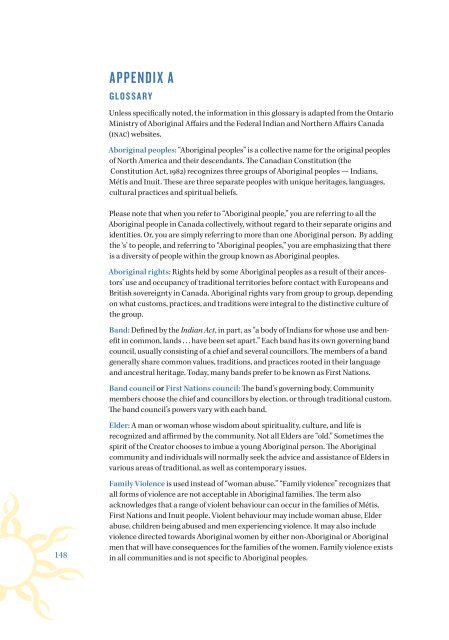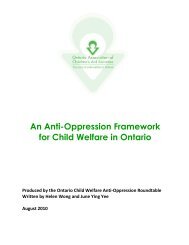English - Ontario Association of Children's Aid Societies
English - Ontario Association of Children's Aid Societies
English - Ontario Association of Children's Aid Societies
Create successful ePaper yourself
Turn your PDF publications into a flip-book with our unique Google optimized e-Paper software.
APPENDIX A<br />
GLOSSARY<br />
Unless specifically noted, the information in this glossary is adapted from the <strong>Ontario</strong><br />
Ministry <strong>of</strong> Aboriginal Affairs and the Federal Indian and Northern Affairs Canada<br />
(INAC) websites.<br />
Aboriginal peoples: “Aboriginal peoples” is a collective name for the original peoples<br />
<strong>of</strong> North America and their descendants. The Canadian Constitution (the<br />
Constitution Act, 1982) recognizes three groups <strong>of</strong> Aboriginal peoples — Indians,<br />
Métis and Inuit. These are three separate peoples with unique heritages, languages,<br />
cultural practices and spiritual beliefs.<br />
Please note that when you refer to “Aboriginal people,” you are referring to all the<br />
Aboriginal people in Canada collectively, without regard to their separate origins and<br />
identities. Or, you are simply referring to more than one Aboriginal person. By adding<br />
the ‘s’ to people, and referring to “Aboriginal peoples,” you are emphasizing that there<br />
is a diversity <strong>of</strong> people within the group known as Aboriginal peoples.<br />
Aboriginal rights: Rights held by some Aboriginal peoples as a result <strong>of</strong> their ancestors’<br />
use and occupancy <strong>of</strong> traditional territories before contact with Europeans and<br />
British sovereignty in Canada. Aboriginal rights vary from group to group, depending<br />
on what customs, practices, and traditions were integral to the distinctive culture <strong>of</strong><br />
the group.<br />
Band: Defined by the Indian Act, in part, as “a body <strong>of</strong> Indians for whose use and benefit<br />
in common, lands . . . have been set apart.” Each band has its own governing band<br />
council, usually consisting <strong>of</strong> a chief and several councillors. The members <strong>of</strong> a band<br />
generally share common values, traditions, and practices rooted in their language<br />
and ancestral heritage. Today, many bands prefer to be known as First Nations.<br />
Band council or First Nations council: The band’s governing body. Community<br />
members choose the chief and councillors by election, or through traditional custom.<br />
The band council’s powers vary with each band.<br />
Elder: A man or woman whose wisdom about spirituality, culture, and life is<br />
recognized and affirmed by the community. Not all Elders are “old.” Sometimes the<br />
spirit <strong>of</strong> the Creator chooses to imbue a young Aboriginal person. The Aboriginal<br />
community and individuals will normally seek the advice and assistance <strong>of</strong> Elders in<br />
various areas <strong>of</strong> traditional, as well as contemporary issues.<br />
148<br />
Family Violence is used instead <strong>of</strong> “woman abuse.” “Family violence” recognizes that<br />
all forms <strong>of</strong> violence are not acceptable in Aboriginal families. The term also<br />
acknowledges that a range <strong>of</strong> violent behaviour can occur in the families <strong>of</strong> Métis,<br />
First Nations and Inuit people. Violent behaviour may include woman abuse, Elder<br />
abuse, children being abused and men experiencing violence. It may also include<br />
violence directed towards Aboriginal women by either non-Aboriginal or Aboriginal<br />
men that will have consequences for the families <strong>of</strong> the women. Family violence exists<br />
in all communities and is not specific to Aboriginal peoples.

















